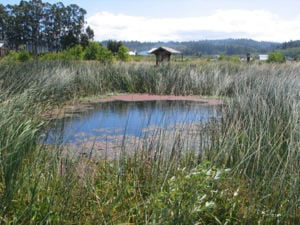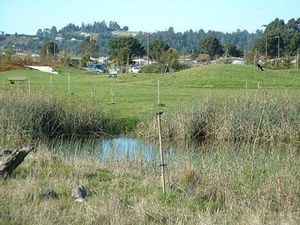
As a part of a much larger storm water treatment system at Potawot, the storm water treatment pond treats 100 percent of the water that is channeled into the system. This water comes from parking lot and building runoff from storms. The water is anything but ready to be reintroduced to the ecosystem. The pond's first purpose is to filter the water in a natural way. The pond acts as a natural sponge by removing toxins without harming the environment. Then the water can be reintroduced to the Storm water - Seasonal Wetlands through a culvert.[1][2]
The second purpose of the treatment pond is to encourage natural habitat. The pond's design includes raised islands which create a resting place for water fowl. It is also home to the Three Spine Stickleback, a highly adaptive 6-10 cm long fish, which is indigenous to Humboldt County. Two other indigenous species that the pond is home to are the Red Legged Tree-Frog and the Western Frog. This is to promote sustainability of the environment at Potawot.[1]
Design - How it works[edit | edit source]
Potawot swales channel storm water directly into the treatment pond. The water travels both above the ground surface and below. As the water reaches the pond, aerobic treatment begins on the surface. At the bottom of the pond, metals settle out and collect.[1][2]
The pond's center is the deepest point where the depth ranges from 5-6 feet. The edges are extremely shallow, between 2-3 feet deep, to allow plants to grow naturally there. This is so that the water gets circulated throughout plant matter on the outer part of the pond, creating a flowing cycle. This circulation is called the pond's "fetch." Bacteria thrive on the parts of the plants that are submerged in the pond. These bacteria eat and digest the polluting chemicals. Chemicals from Potawot are composed of average storm water byproducts plus the presence of oil from the parking lot runoff. More specifically, the storm water treatment pond is there to treat alkalinity, BOD5, chloride, COD, suspended solids, settleable solids, total dissolved solids, and trace amounts of other harmful chemicals. The treatment process decontaminates the water over time.[1][3]
Plants that are used in the treatment pond include:
- Scirpus Microcarpus (Small Fruited Bulrush)
- Scirpus Acutus (Soft Stemmed Bulrush)
- Carex Obnupta (Slough Sedge)

- Juncus Effuses (Juncus)
- Aleopecirous Geniculatus (Water Foxtail)
- Glyceria Occidentalis (Western Manna Grass)
- Equisetum Hymale (Scouring Sedge)
- Mimulus Gutatus (Yellow Monkeyflower)
- Salix (Willow; various species)
- Spirea Douglasii (Hardhack)
- Potamogeton Natans (Floating-Leaved Pondweed)
- Nuphar Polysepalum (Yellow Pond-Lily)[1]
Cleaned water flows into a box which rests half-submerged in the treatment pond. This moves the water to a culvert that drains into the Storm water - Seasonal Wetlands of Potawot where it is reintroduced to the natural ecosystem.[1]
The pond was designed with Franciscan Mirage (also called "blue glue"), a hard clay. This clay layer acts as a barrier under the pond, soil, and vegetation to prevent toxins as well as water from escaping the area. The image shows excavation done before laying the clay layer.[1]
Location - Potawot[edit | edit source]

Potawot is located in Arcata, CA (Humboldt County) on a 40 acre site adjacent to Mad River Community Hospital. The storm water treatment pond is located behind the main health center complex, just before the wetlands. The map highlights in red the pond.[2]
October 2013 Update[edit | edit source]
Vegetation has increased vastly since the creation of the ponds increasing the healthiness of wetland ecosystem by potentially providing more water treatment. The increase in vegetation has made it slightly more difficult to access drains for maintenance.
-
Looking into the "Too-Mahnocks Pond", vegetation become increasingly thick.
-
Pond closest to main complex and the only one easily accessible.
-
Dry Wetland on the Southern part of property with water gauge.
-
South eastern wetland from trail.
Update October 2014[edit | edit source]
The vegetation has continued to increase and although it boosts the wellness of the wetland ecosystem by increasing water treatment, challenges arise. The increase in vegetation has also continued to make it more difficult to access drains for maintenance. Accessing the pond itself is difficult because of the dense vegetation around it.
-
Pond closest to Health Center
-
Metal mesh and biomass next to pond
-
Small piece of metal mesh material in pond
Update October 2017[edit | edit source]
Although dense vegetation has grown around the stormwater treatment pond, it is still considered to be a valuable resource to the Potawot community garden. The swales circling the clinic catch stormwater and channel it to the pond where it is treated through an aerobic process. Tule, or "Too-mahnocks" as the Yurok tribe calls it are one of the main plants that treat the pond. As the sign next to the pond illustrates, the thick mesh of the tule stems slow down stormwater that enters the wetlands from the swales. As the flow slows, all the dirt and oils in the runoff settle to the bottom of the pond or are trapped in the mesh of the tule. The tule also provides a great home for microorganisms!
The dense tule around the treatment pond as well as other vegetation surrounding (and even growing out of the pond) make it difficult to access as well as even see from the trail. Currently, Potawot's maintenance staff is slightly understaffed, says one landscaper, which could account for the overgrown plants. Luckily, the pond is maintaining its use regardless of its disheveled aesthetic.
-
current stormwater pond near the clinic
-
stormwater pond information posted next to water
-
dense vegetation makes pond difficult to access
-
swale making its way into treatment pond
Update September 2018[edit | edit source]
The Potawat Storm drainage pond is thriving, many native plants such ass tule, wormwood, and willow grow in and around this pond, creating a great plant diversity. As of right September 2018 it appears that willows are currently out competing for sunlight. This means that the tule, long green shoots, are no longer getting as much access to the sunlight. It was well maintenanced about five feet from the path but the pond itself was not managed.
The storm drainage pond has been in effect since 1998. With a twenty year span the once barren farmland has been transformed back to a successful thriving wetland ecosystem. The storm drainage pond utilizes it's clay bottom and tule weed that grows out out it, to provide a place for many insects and bacteria to thrive. The parking lot runoff and garden runoff both lead to this drainage pond. With the help of this ecosystem, that water is slowly, naturally filtering out the metals and allowing the filtered water to seep into the groundwater.
-
current storm drainage pond
-
stormwater pond information posted next to water
-
Stream from the Boardroom pond to the storm drainage Pond
-
Boardroom Pond connected to the storm drainage pond
-
Float Valve to keep the pond from over filling
-
Plants found in and around Storm drain wetlands
References[edit | edit source]
- ↑ 1.0 1.1 1.2 1.3 1.4 1.5 1.6 Eric Johnson. Personal Communication. 10-27-2008.
- ↑ 2.0 2.1 2.2 Potawot Health Village: Integrating Health, Community and the Environment. Accessed online 10/24/08. http://www.humboldt1.com/~water/main_pages/PHVP.html
- ↑ Principles of Environmental Engineering and Science(2nd edition). Textbook reference. Davis Masten. McGraw Hill Publishers. 2009.














